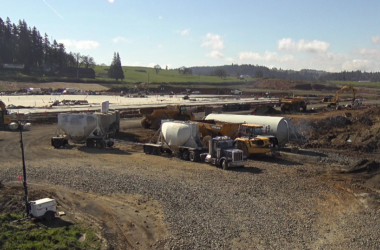
A ‘Now Hiring’ sign in front of the Boon’s Treasury McMenamin’s location on Monday, April 26. (Amanda Loman/Salem Reporter)
With “no real signs of permanent damage or economic scarring” from the pandemic, Oregonians’ incomes are expected to grow and the labor market is expected to return to full health by 2023, according to the most recent state economic forecast.
The forecast, released last week, offers a markedly optimistic picture of the state’s economy in the coming years. While the outlook is a stark reversal from the doom-and-gloom forecast issued last fall, it points out economic challenges facing the Salem area and the rest of the state.
Since the pandemic hit, the federal government has pumped money into the economy in the form of stimulus payments, added unemployment payments and loans. That’s resulted in incomes 20% higher than they were before the pandemic, the forecast said.
“Excluding the direct federal aid, incomes are back to pre-pandemic levels and expected to grow 6-7% this year and next,” reads the forecast.
Unlike previous recessions, this recovery is awash in jobs, the forecast notes, and companies are currently advertising at least as many positions as before the pandemic.
With consumers flush with cash, Oregon’s unemployment rate will return to 4% by 2023, according to the forecast. The unemployment rate for Oregon and the Salem area is currently hovering at around 6%. It expects “front-loaded” job growth with the largest employment gains occurring over the summer and fall.
“Services like air travel, barbershops, hotels, nail salons, restaurants, and the like are labor intensive,” the forecast said. “These industries will need to staff back up quickly to meet consumer demand.”
During the recovery, employers have complained of labor shortages. The forecast reports that over half of Oregon employers have reported difficulty hiring for open jobs.
According to the forecast, strong household finances, as well as the lack of childcare and in-person schooling are contributing to the tight labor market. Employers can continue to expect a tight labor market for the foreseeable future with Baby Boomers retiring, the forecast said. That’ll also contribute to “strong wage gains and more plentiful job opportunities,” according to the forecast.
The economy quickly roaring back brings the risk that supply for some materials “cannot keep pace with demand,” the forecast said. With inventories lean and demand strong, the forecast points to shortages of semiconductors, lumber and rental cars, creating “bottlenecks.” Inflation will also “undoubtedly” pick up in the months ahead as production costs rise, the forecast said. However, the forecast expects price pressures to be “transitory.”
“Production needs to increase to meet the strong level of sales, which boosts overall economic growth,” said the forecast. “However many manufacturing sectors are already operating at or near capacity. They are constrained.”
Manufacturing employs 184,000 people in Oregon, a decrease of 5.5% since the pandemic.
That has particular relevance for the Salem area and the mid-Willamette Valley where manufacturing is a key industry. According to Oregon Employment Department numbers, manufacturing is one of the largest industries in the area and employs nearly 29,000 people in the mid-Willamette Valley. Since last year, manufacturing jobs have decreased by 5% in the Salem area.
While manufacturers could begin rehiring workers, the shock to supply chains could leave “local firms out of the loop,” the forecast states.
However, food manufacturing, which employs 6,100 people in the region, has proved unexpectedly resilient during the pandemic, according to the forecasts. That’s despite the collapse of NORPAC, a large food processor in the Salem area, and the industry being prone to Covid outbreaks.
“Food manufacturing is the brightest, and most surprising manufacturing development in Oregon in the past year,” said the forecast. “This is the only subsector where local employment is outperforming national employment since the pandemic hit.”
Another bright spot in the forecast is child poverty. The American Rescue Plan Act, signed by President Joe Biden, included an expansion of the Child Tax Credit. The expanded credits will boost the average Oregon family’s after-tax income by $2,000 and is estimated to cut child poverty by 46% in the state.
Urban areas, like Salem, have suffered more than rural areas during the pandemic with the lack of foot traffic from commuters and drops in demand for nightlife entertainment from local residents and tourists, according to the forecast.
But the forecast contained potentially good news for the Salem area, where state government is the largest employer. Funds from the American Rescue Plan Act will direct $4.6 billion to Oregon cities, counties and the state.
If the optimistic recovery scenario outlined in the forecast comes to pass, revenues in the upcoming two-year budget cycle would increase by $576 million meaning that layoffs that happened during the previous recession are less likely.
Contact reporter Jake Thomas at 503-575-1251 or [email protected] or @jakethomas2009.
JUST THE FACTS, FOR SALEM – We report on your community with care and depth, fairness and accuracy. Get local news that matters to you. Subscribe to Salem Reporter starting at $5 a month. Click I want to subscribe!









